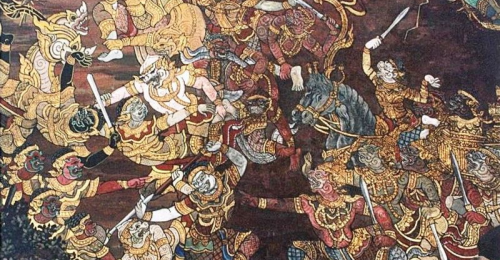 |
| A Thai depiction of Rama-Ravana battle |
Lazarus was a man who lived in the town of Bethany near Jerusalem. When he was ill, his sisters called for Jesus, but by the time Jesus reached, Lazarus was dead. In the presence of the mourners, Jesus had the stone of the tomb rolled away and called for Lazarus and he got up and walked in his grave clothes. Besides this story, the gospels contain other miracles attributed to Jesus like walking on water, converting water to wine and feeding a large crowd with a few loaves of bread and fish.
The historians of the 1st century wrote nothing about Jesus and so modern day scholars have to rely on the gospels, which contain stories like these to find out details of the historical Jesus. Instead of dismissing the story of Jesus as a myth, biblical scholars look for places mentioned in the gospels, conduct archaeology and try to reconstruct the life of the historical Jesus.
All epics have a seed story which then gets layered with exaggeration, poetic imagination and addition by later scribes. Mahābhārata started out with the name Jaya with just 8800 verses by Vyasa. It increased to 24,000 verses when it was recited by Vaisampayana and it reached the size of 100,000 verses when it was recited by Ugrasravas, the son of Lomaharsha. Theravada Buddhists have a version of Ramayana in the Jatakas which does not have the abduction of Sita. While Biblical scholars affiliated with prestigious universities in the west look at texts, they know that the texts contain theology and modifications, but still try to find out their historical basis. No such work was done by the ASI or the Central Government.
In Stanford University, there is a course called The Historical Jesus, which attempts to disconnect Jesus Christ from Yeshua, which was his actual name. (Christ just means the anointed one, like how Buddha means the awakened one). There are many Biblical scholars who look at the scriptures from a historical perspective without getting into theology. Biblical archaeology has led to the discovery of structures like the Pool of Siloam, Second Temple, Shechem temple, Jericho’s walls and artifacts like Ebla cuneiform archives, Arad ostraca, and Caiaphas family ossuaries. If the story of Jesus was dismissed as a myth, none of this would have happened.
When it comes to providing support for such research, the Archaeological Survey of India does not have a good track record. Few years back, there was an effort initiated by Jagmohan to conduct archaeology along the path of Saraswati river. The excavations at Adi Badri in Haryana revealed a 300 AD Kushan site. Excavations in Dholavira in Kutch revealed one the world’s oldest stadiums and sign boards. These excavations would have revealed more about our past, and answered questions like: Were the Harappans the Vedic people, but the project was scrapped. While there have been some excavations in Hastinapur and Kurukshetra, archaeology related to Ramayana is non existent.
While the Government is sure that Rama did not exist, historians disagree. A. L. Basham writes that Rama may have been a chief who lived in the 8th or 7th century BCE who did not have any divine attributes. He goes on to write that Rama and Dasaratha were insignificant chieftains, who were ignored by the Puranas, but whose exploits were remembered, elaborated and magnified by by bards. Rama’s father-in-law, Janaka of Videha, is mentioned a few times in literature and Basham says, is definitely a historical figure. Romila Thapar, our favourite eminent historian and disciple of Basham, says that the original version of Ramayana was an exaggerated version of local conflicts occuring between the expanding kingdoms of the Gangetic plain and the societies of the Vindhyan region.
The ASI has ignored the work of historians and have not tried to find the details of the local conflicts which resulted in Ramayana. They have not analyzed Ramayana from a historical perspective like the Biblical scholars and they have not conducted archaeology related to Rama, but still have concluded with confidence that Rama was not a historical figure.
See Also: Faith, fact and fiction, The Ramayana, the Sethusamudram and Indian Archeology
